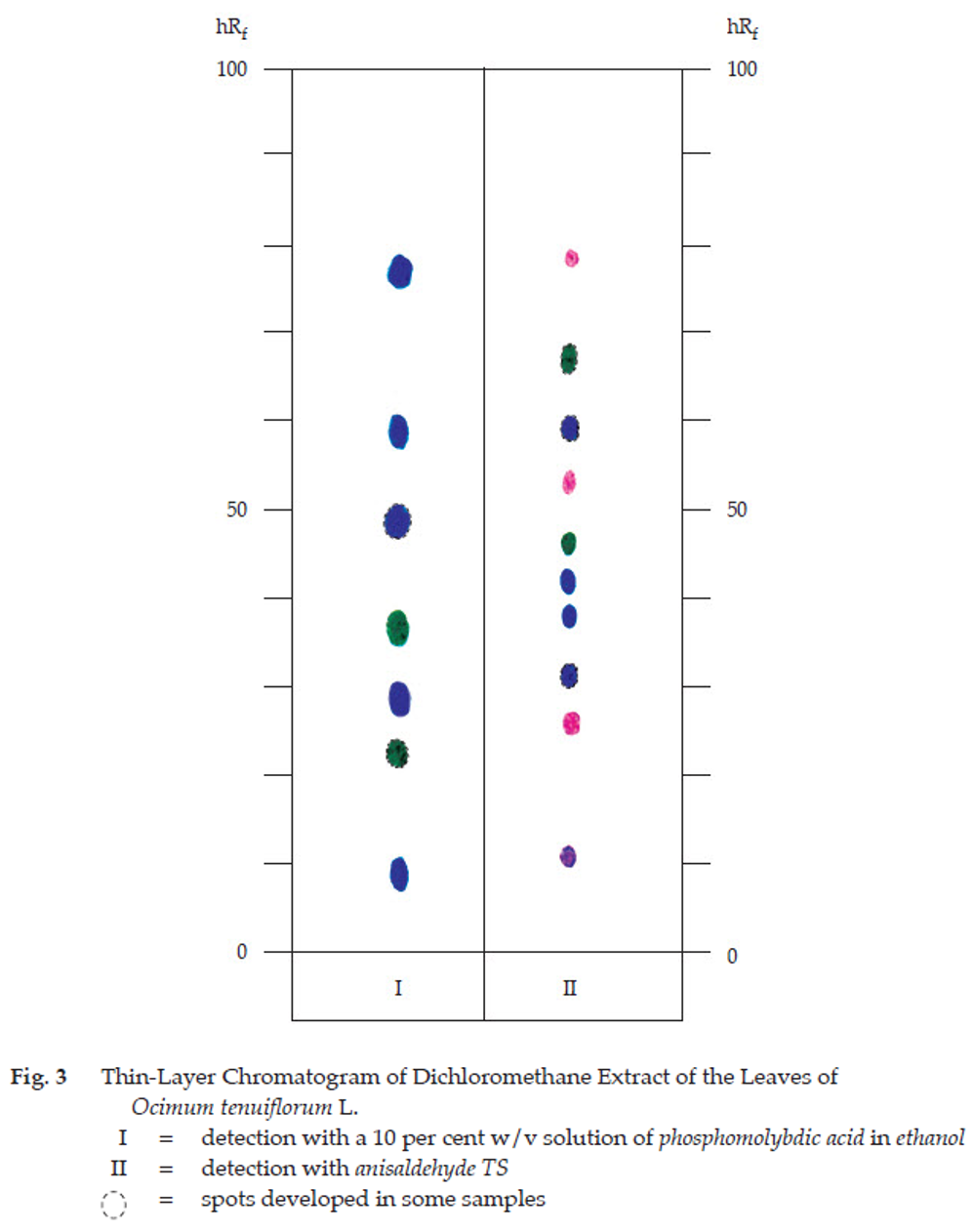ตำรามาตรฐานยาสมุนไพรไทย
Thai Herbal Pharmacopoeia
สำนักยาและวัตถุเสพติด กรมวิทยาศาสตร์การแพทย์ กระทรวงสาธารณสุข
Bureau of Drug and Narcotic, Department of Medical Sciences, Ministry of Public Health(Tinospora crispa (L.) Hook.f. & Thomson)
(Nelumbo nucifera Gaertn.)
(Centella asiatica (L.) Urb.)
(Centella Dry Extract)
(Centella Cream)
(Mesua ferrea L.)
(Piper sarmentosum Roxb.)
(Piper sarmentosum Roxb.)
(Pterocarpus santalinus L. f.)
(Santalum album L.)
(Senna tora (L.) Roxb.)
(Senna alata (L.) Roxb.)
(Senna Alata Tea)
(Piper retrofractum Vahl)
(Myristica fragrans Houtt)
(Andrographis paniculata (Burm. f.) Nees)
(Andrographis Capsules)
(Allium ascalonicum L.)
(Ocimum tenuiflorum L.)
(Curcuma longa L.)
(Turmeric Capsules)
(Turmeric Dry Extract)
(Turmeric Dry Extract Capsules)
(Arcangelisia flava (L.) Merr.)
(Curcuma sp.)
Harrisonia perforata (Blanco) Merr.
(Aristolochia pierrei Lecomte)
(Zingiber officinale Roscoe)
(Ginger Capsules)
(Ginger Tea)
(Cassia fistula L.)
(Nardostachys jatamansi (D. Don) DC.)
(Angelica sinensis (Oliv.) Diels)
Artemisia annua L.
(Ligusticum sinense Oliv. cv. Chuanxiong)
(Neopicrorhiza scrophulariiflora Pennell)
(Atractylodes lancea (Thunb.) DC.)
(Aucklandia lappa Decne)
(Terminalia chebula Retz.)
(Angelica dahurica (Hoffm.) Benth. & Hook. f. ex Franch. & Sav. var. dahurica)
(Kaempferia parviflora Wall. ex Baker)
(Hibiscus sabdariffa L.)
(Roselle Tea)
(Allium sativum L.)
(Zingiber zerumbet (L.) Sm.)
(Wurfbainia testacea (Ridl.) Škorničk.& A. D. Poulsen)
(Cannabis sativa L.)
(Myristica fragrans Houtt)
(Dracaena cochinchinensis (Lour.) S. C. Chen)
(Ficus racemosa L.)
(Hyptis suaveolens (L.) Poit.)
Clerodendrum indicum (L.) Kuntze
(Phyllanthus emblica L.)
(Citrus hystrix DC.)
(Citrus hystrix DC.)
(Areca catechu L.)
(Momordica charantia L.)
Moringa oleifera Lam.
(Aegle marmelos (L.) Corrêa)
(Solanum trilobatum L.)
(Morus alba L.)
Gynostemma pentaphyllum(Thunb.)
Makino
(Clinacanthus nutans (Burm. f.) Lindau)
(Cissus quadrangularis L.)
(Mimusops elengi L.)
(Zingiber montanum (J. König) Link. ex A. Dietr.)
(Piper betle L.)
(Capsicum annuum L.)
(Capsicum Oleoresin)
(Capsicum Gel)
(Piper nigrum L.)
(Piper nigrum L.)
(Eurycoma longifolia Jack)
(Thunbergia laurifolia Lindl.)
(Piper wallichii (Miq.) Hand.-Mazz.)
Senna garrettiana (Craib) H. S. Irwin & Barneby
(Terminalia bellirica (Gaertn.) Roxb.)
(Terminalia chebula Retz.)
(Caesalpinia bonduc (L.) H. Roxb.)
(Tarlmounia elliptica (DC.) H. Rob., S. C. Keeley, Skvaria & R. Chan)
(Hog Creeper Vine Dry Extract Capsiles)
(Hog Creeper Vine Dry Extract)
(Brachypterum scandens (Roxb.) Miq.)
(Lepidium sativum L.)
(Nigella sativa L.)
(Cuminum cyminum L.)
(Foeniculum vulgare Mill.)
(Plantago ovata Forssk.)
(Pimpinella anisum L.)
(Carum carvi L.)
(Anethum graveolens L.)
(Trachyspermum ammi (L.) Sprague)
Albizia procera (Roxb.) Benth.
(Acorus calamus L.)
(Tiliacora triandra (Colebr.) Diels)
Cyanthillium cinereum (L.) H. Rob.
(Orthosiphon aristatus (Blume) Miq.)
Murdannia loriformis (Hassk.) R. S. Rao & Kammathy
(Capparis micracantha DC.)
(Chrysopogon zizanioides (L.) Roberty)
(Cyperus rotundus L.)
(Cannabis sativa L.)
(Syzygium aromaticum (L.) Merr. & L. M. Perry)
(Boesenbergia rotunda (L.) Mansf.)
(Acanthus ebracteatus Vahl)
(Acanthus ilicifolius L.)
(Kaempferia galanga L.)
(Curcuma comosa Roxb.)
Betula alnoides Buch.-Ham. ex D. Don
Cannabis sativa L.
Carthamus tinctorius L
Mitragyna speciosa (Korth.) Havil
Mallotus repandus (Rottler) Müll. Arg
Azadirachta indica A. Juss. var. siamensis Valeton
Azadirachta indica A. Juss. var. siamensis Valeton
Punica granatum L.
Rhinacanthus nasutus (L.) Kurz
Baliospermum solanifolium (Burm.) Suresh
Curcuma aeruginosa Roxb
Boesenbergia kingii Mood & L. M. Prince
Senegalia rugata (Lam.) Britton & Rose
Acacia concinna (Willd.) DC.
Senegalia rugata (Lam.) Britton & Rose
Acacia concinna (Willd.) DC.
Senna alexandriana Mill. var. alexandriana
Cassia acutifolia Delile, Cassia angustifolia Vahl
Butea superba Roxb. ex Willd.
[Plaso superba (Roxb. ex Willd.) Kuntze, Rudolphia superba (Roxb. ex Willd.) Poir.
Pueraria candollei Graham
ex Benth. var. mirifica (Airy Shaw & Suvat.) Niyomdham
Streblus asper Lour.
Suregada multiflora (A. Juss.) Baill. (Gelonium
multiflorum A. Juss.
Plumbago zeylanica L.
Plumbago indica L.
Biancaea sappan (L.) Tod.
Ziziphus attopensis Pierre
Streblus asper Lour.
Justicia gendarussa Burm. f.
Enhalus acoroides (L. f.) Royle
Bridelia ovata Decne.
Tamarindus indica L.
Citrus × aurantiifolia (Christm.) Swingle
Garcinia mangostana L.
Blumea balsamifera (L.) DC
Persicaria odorata (Lour.) Soják
Zingiber montanum (J. König) Link ex A. Dietr.
Mammea siamensis (Miq.) T. Anderson
Citrus maxima (Burm.) Merr.
Citrus × aurantium L. ‘Som Sa’
Punica granatum L.
Rhinacanthus nasutus (L.) Kurz
Holy Basil Leaf is the dried leaf of the red variety of Ocimum tenuiflorum L. [O. sanctum L., O. monochorum L., O. album Blanco, O. flexuosum Blanco, O. nelsonii Zippelius ex Spanoghe, O. virgatum Blanco, O. brachiatum Hasskarl, Moschosma tenuiflorum (L.) Heynh.] (Family Labiatae), Herbarium Specimen Number: DMSC 43, 418, Crude Drug Number: DMSc 0273
Constituents Holy Basil Leaf contains up to about 1.7 per cent of volatile oil, of which methyl eugenol, caryophyllene and methyl chavicol are its major components. It also contains β-carotene, sterols, fatty acids, etc.
Description of the plant (Figs. 1a, 1b) Herb 30 to 60 cm tall; erect, aromatic, much branched, twigs usually purplish, subquadrangular, clothed with soft spreading hairs, often woody at the base. Leaves simple, opposite, elliptic-oblong or elliptic, 3 to 6 cm long, 1 to 2.5 cm wide, apex acute or obtuse, base acute or obtuse, margin entire or serrate, membranous, pubescent on both surfaces, lower surface more hairy on midrib; petiole, 1 to 3 cm long, slender, hairy. Flower in terminal raceme of verticillasters, 8 to 10 cm long; bract 2 to 3 mm long, broadly ovate with acuminate apex, ciliated; pedicel 3 to 4.5 mm, slender, pubescent. Flower: calyx tubular-bilabiate, about 2.5 mm (in fruit 3 to 3.5 mm) long, glabrous inside (pubescent outside), the upper lip broadly obovate, flat, the lower lip 4-toothed, the 2 central with long slender awns which project beyond the upper lip and are much curved upwards; corolla purplish, tubular-bilabiate, the upper lip 4 of almost equal lobes, pubescent on the back, lower lip, the longest lobe and ascending; stamens 4, epipetalous, exserted, filaments slender, the upper pair with a small bearded basal appendage. Fruit small, 4-seeded nutlets. Seed ovoid, brown, nearly smooth, about 1.2 mm long.
Description Odour, aromatic; taste, slightly pungent.
Macroscopical (Fig. 1a) Leaves, wrinkled and broken; entire leaves, elliptic-oblong, 2 to 5 cm long and 1 to 3 cm wide; petiole 1 to 3 cm long, greenish brown.
Microscopical (Figs. 2a, 2b) Transverse section of the leaf shows upper epidermis, a single layer of rectangular cells containing reddish purple matters. Mesophyll consisting of a single layer of palisade parenchyma and several layers of more or less rounded spongy parenchyma, rich in chloroplastids. Through this region, scattered the small vascular bundles. Lower epidermis, a single layer of rectangular cells, no colouring matters, non-glandular and glandular trichomes occur as outgrowths from lower epidermis more abundant than upper epidermis. The non-glandular trichomes are uniseriate, 1 to 7 cells, some of the cells are more or less collapsed. The glandular trichomes have a 1-celled stalk and 2- to 4-celled glandular head. Transverse section through the midrib of the lamina shows the 2 or 3 layers of angular collenchyma underneath the epidermis, parenchyma and collateral vascular bundles.
In surface view, the epidermides of upper and lower surfaces are wavy-walled polygonal cells with diacytic stomata.
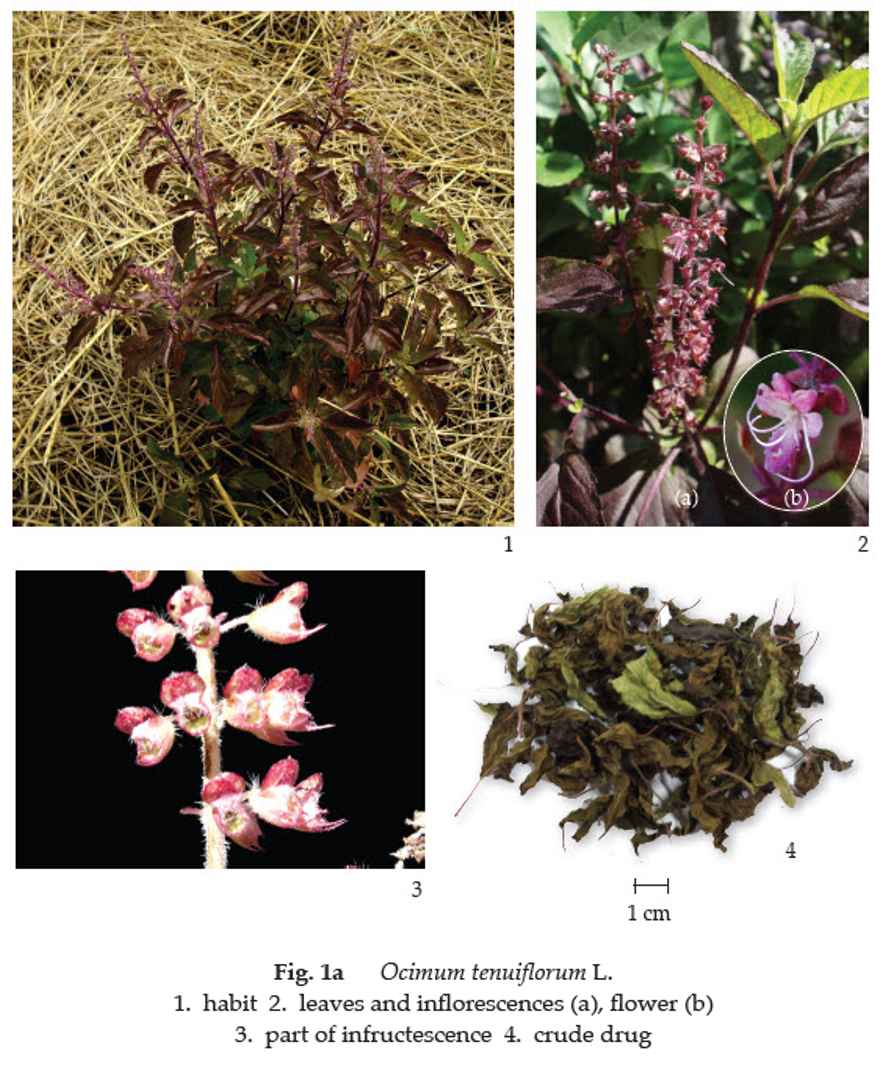
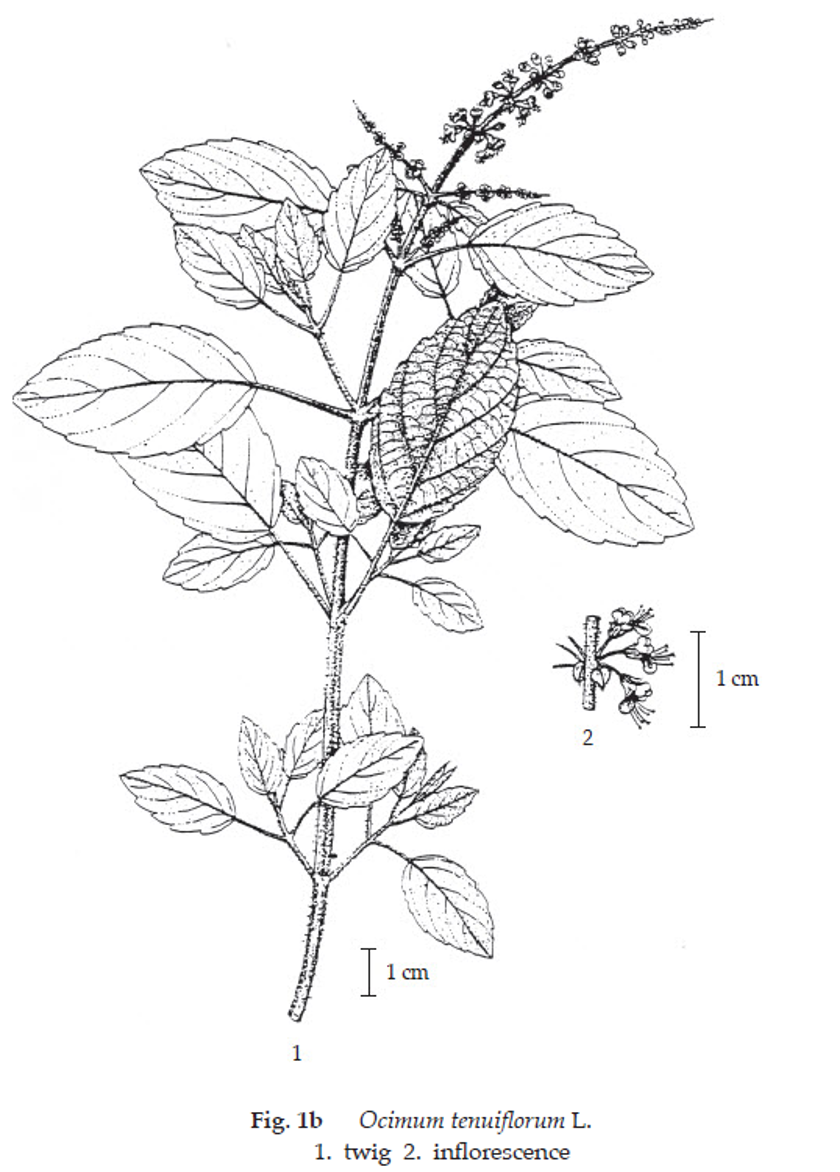
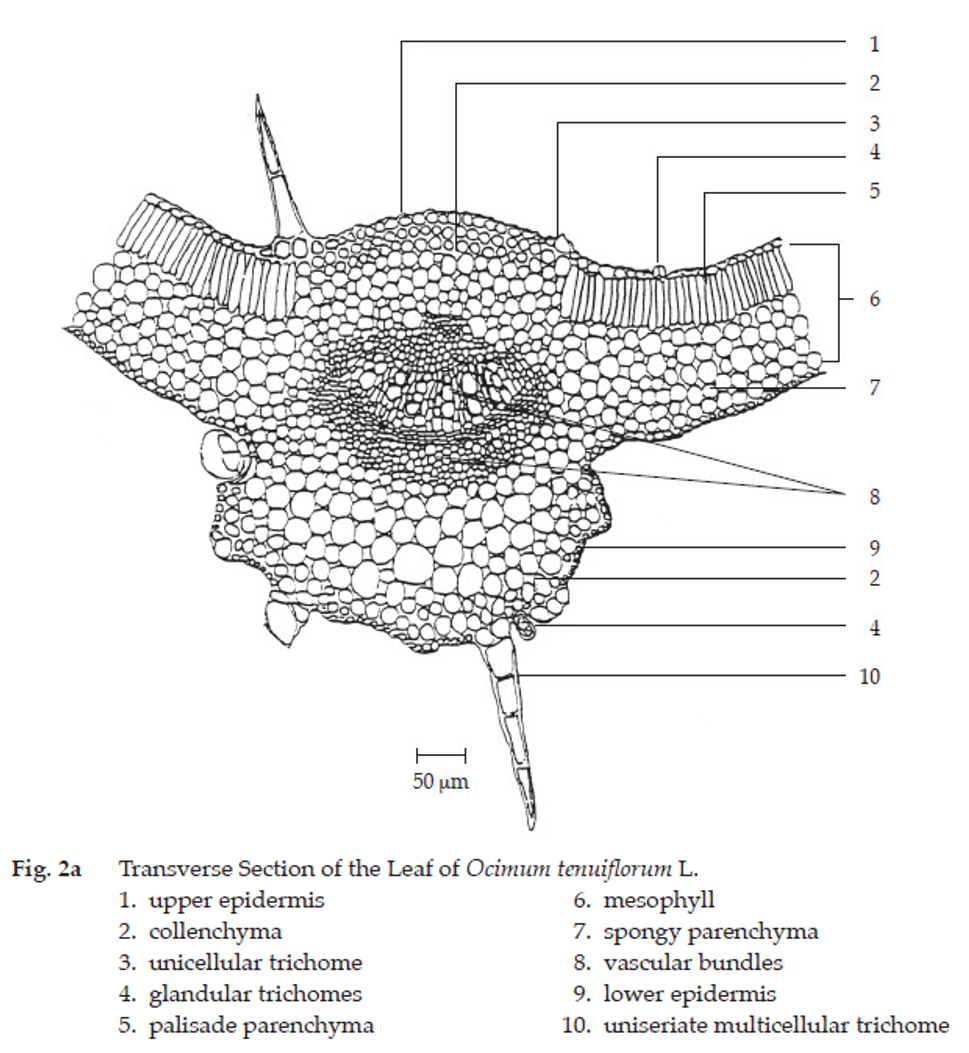
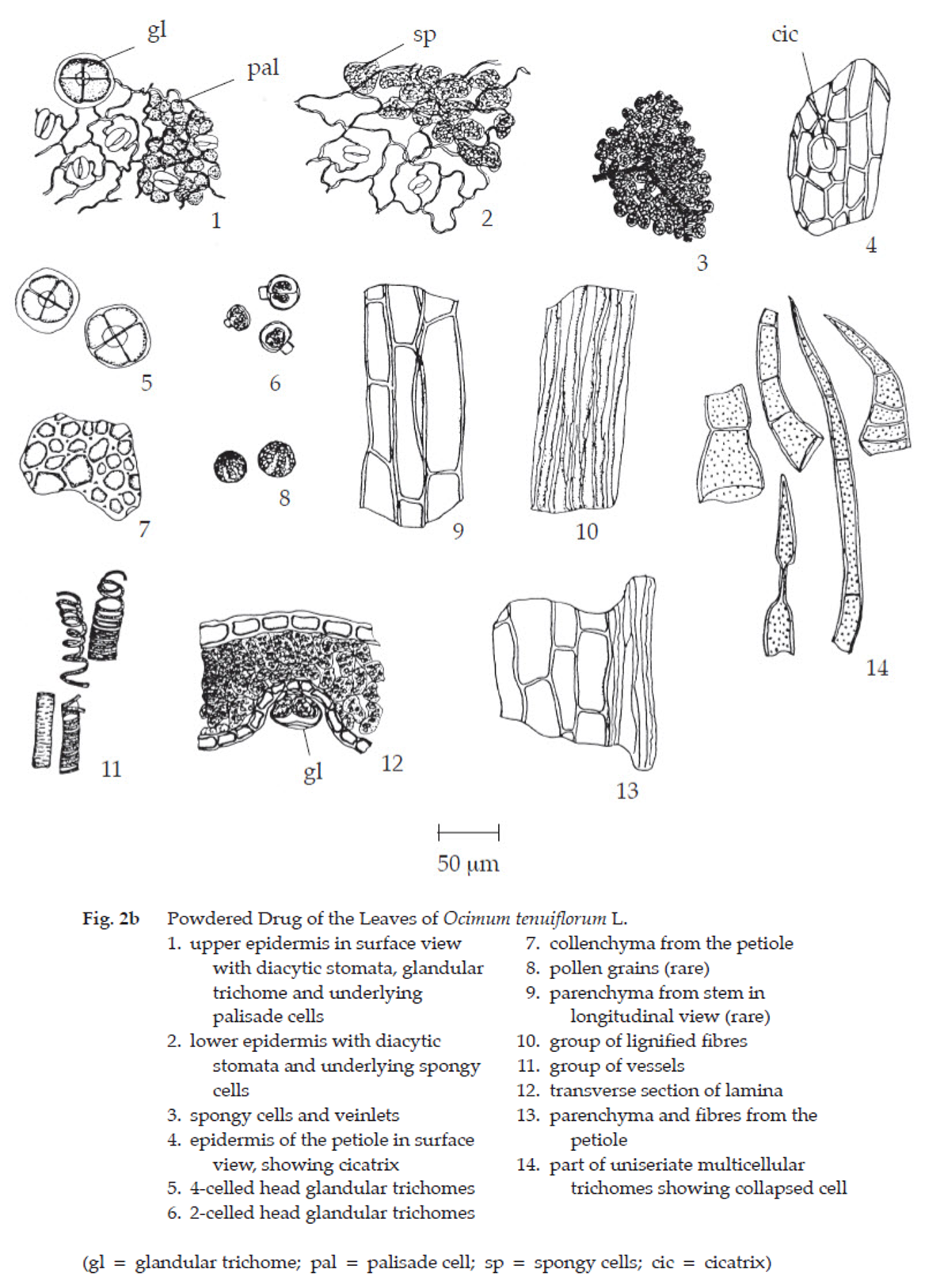
Holy Basil Leaf in powder possesses the diagnostic microscopical characters of the unground drug.
Packaging and storage Holy Basil Leaf shall be kept in well-closed containers, preferably of metal or glass, protected from light and stored in a cool and dry place.
Identification
A. To 500 mg of the sample, in powder, add 2 mL of acetic anhydride, warm on a water-bath for about 2 minutes, shake, and filter. Slowly add 1 mL of sulfuric acid to the filtrate to form a layer: a brownish red ring forms at the zone of contact.
B. Add 10 mL of water to 500 mg of the sample, in powder, heat for 2 minutes and filter. To 2 mL of the filtrate, add 1 drop of a 5 per cent w/v solution of iron(III) chloride: a green precipitate is produced.
C. Add 10 mL of water to 500 mg of the sample, in powder, boil for 2 minutes and filter. To 3 mL of the filtrate, add 1 drop of potassium cupri-tartrate TS and warm: a brick-red precipitate is produced.
D. Carry out the test as described in the “Thin-Layer Chromatography” (Appendix 3.1), using silica gel G as the coating substance and a mixture of 75 volumes of chloroform and 25 volumes of benzene as the mobile phase. Apply to the plate, 10 μL of the test solution, prepared by shaking 100 mg of the sample, in powder, with 2 mL of dichloromethane for about 15 minutes and filtering. Evaporate the filtrate on a water-bath to dryness and dissolve the residue in 0.5 mL of toluene. After removal of the plate, allow it to dry in air and spray with a 10 per cent w/v solution of phosphomolybdic acid in ethanol. Heat at 105° to 110° for 5 to 10 minutes. Several spots of different colours are observed (Table 1); see also Fig. 3.
Repeat the same procedure on another plate. After removal of the plate, allow it to dry in air. Spray the plate with anisaldehyde TS; several spots of different colours are observed (Table 1); see also Fig. 3.
Table 1 hRf Values of Components in Dichloromethane Extract of the Leaves of Ocimum tenuiflorum L.
| Spot | hRf Value | Detection | |
| 10 Per Cent W/V Solution of Phosphomolybdic Acid in Ethanol |
Anisaldehyde TS | ||
| 1 2 3 4 5 6 7 8 9 10 11 |
5-10 15-22 23-28 29-32 33-35 36-38 39-45 50-55 56-65 66-70 75-80 |
blue green blue - green - - blue blue - blue |
violet - pink blue blue blue green pink pale blue green pink |
Water Not more than 14.0 per cent v/w (Azeotropic Distillation Method, Appendix 4.12).
Acid-insoluble ash Not more than 2.0 per cent w/w (Appendix 7.6).
Sulfated ash Not more than 20.0 per cent w/w (Appendix 5.3).
Ethanol-soluble extractive Not less than 5.0 per cent w/w (Appendix 7.12)
Water-soluble extractive Not less than 20.0 per cent w/w (Appendix 7.12).
Chloroform-soluble extractive Not less than 5.0 per cent w/w (Appendix 7.12H).
Volatile oil Not less than 1.0 per cent v/w (Appendix 7.3H). Use 50 g of hand-crushed leaves, accurately weighed. Use 1000 mL of water as the distillation liquid and a 2.5-L round-bottomed flask. Distil at a rate of 2 to 3 mL per minute for 5 hours. Use 2.0 mL of xylene in the graduated tube.
